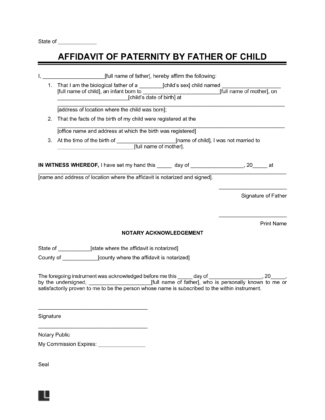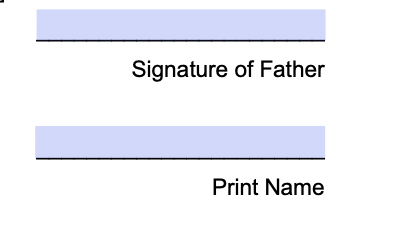
Use our Affidavit of Paternity form to acknowledge paternity for a child born outside of marriage.

Updated February 3, 2023
Written by Josh Sainsbury | Reviewed by Brooke Davis
An Affidavit of Paternity is a document used to establish a child’s paternity and can be used to add information about a child’s father to the child’s birth certificate.
It is intended to be used by couples who were not married when the child was conceived or born, and it can be completed at any time after a child’s birth.
An Affidavit of Paternity is a legally binding document acknowledging paternity by the parents of a child. Typically, a married man is presumed to be the father of his wife’s child as a matter of law. But unwed parents are responsible for establishing paternity for their children.
So a mother and father can sign an affidavit that states the male who signed the document is the baby’s father.
The Affidavit of Paternity is a straightforward form used in a court proceeding. It conveys legal and familial rights and obligations for the father, such as child care, custody, and support for the rest of the child’s life.
Once paternity is established, the child will be entitled to inherit the parents’ estate if their parents pass away.
The document focuses on the biological father because there is no way to prove who the child’s father is without DNA testing on the baby. Instead of contesting fatherhood and requiring genetic tests, many parents use an Affidavit of Paternity to establish the father’s identity.
This saves a great deal of time, money, and stress that might occur from a contested court or paternity hearing.
Signing an Affidavit of Paternity form is a voluntary process. So using this document is best suited when the father does not contest that he is the child’s biological father. This form can help avoid arguments or legal conflicts if both parents agree.
Unmarried parents are the most common people who use Affidavit of Paternity forms. If an unmarried woman gives birth to a child and has a male partner, he isn’t automatically presumed to be the father. It takes something more to prove paternity.
Couples commonly sign the document at the hospital, but establishing paternity can happen anytime after the child’s birth.
In addition to establishing paternity, completing the Affidavit of Parentage form protects custody rights. Under most state laws, an unmarried mother is entitled to full child custody.
The father is not granted custody rights unless his paternity is proven in some way. An Affidavit of Paternity helps protect the father’s custody rights and responsibilities. These may include:
Some parents may also enter into a cohabitation agreement if they want to live together and share custody of the child.
You can get an Acknowledgment of Paternity form when the baby is born at a local hospital or child custody office. Each state has a different entity that provides these forms. But your state’s child custody or family services department should be able to direct you to the right resource.
Download our paternity acknowledgment form or use the document builder, which guides you step by step and ensures you meet specific legal requirements.
When writing your Affidavit of Paternity, you must include basic details about the father, the mother, and the child.
This provides the information necessary to identify all parties related to the child.

Your child’s birth should have been registered with a birth certificate at the vital statistics register of the child’s county and state. Write down the name and address of the essential statistics register where your child’s birth was registered.

The Affidavit of Paternity is intended to be used by couples who were not married when the child was conceived or born. This section should state that you and the other parent aren’t married.

Before signing the affidavit, you must fill in the date and provide the address of the notary public that will notarize the document.

The final step is including your signature, affirming that you are the child’s father, and accepting the associated responsibilities and legal implications.

A notary public is a state officer who serves as a neutral witness when important documents are signed. Affidavits must always be notarized to prove the signee’s identity and the document’s truthfulness.
Whichever state this affidavit is notarized in determines how it’s interpreted in the event of a dispute. If any legal matters arise from this affidavit, signees may be required to go to court in the county where the document was notarized.
Depending on your state, notary publics may be required to pass an exam or take a course to take on their roles. You can find notary publics through sites like the American Association of Notaries.
You should include certain essential items in your Paternity Affidavit. Your specific situation may warrant adding or deleting items as necessary, but these are some of the most commonly included provisions:
The paternity affidavit should include the parent’s and child’s names, addresses, social security numbers, and other identifying information. It should also include all parties’ date of birth, state, and delivery country. Some states may require a picture ID as well.
The document’s primary purpose is to establish paternity, so the legal language should be clear and leave no ambiguity. It should state the male signing the affidavit acknowledges that he is the father and does not contest paternity.
Many acknowledgments also waive paternity testing, which may need DNA testing of blood, hair, or a cheek swab. This provision can save time and money and avoid the stress of dealing with testing.
An Affidavit of Paternity is a legal document that implicates both parents’ rights and responsibilities toward the child. It should specify that all parties signing the document do so voluntarily.
If a potential father is unsure if he wants to sign it, he should not do so.
You will have to go to court to establish paternity. But the affidavit should include a section that waives court proceedings for a contested paternity hearing. Contested court proceedings are lengthy and expensive. One of the reasons for signing this agreement is to avoid those difficulties.
Provisions may include an exception to rescind the paternity affidavit. Specific state laws may limit the time a person can do this.
A paternity affidavit should recognize the father’s custody rights or grant him the right to petition a court for parenting time. This can be crucial, as it outlines that the father will have rights and responsibilities for the child.
It will not outline these rights in great detail. Some of these rights may still need to be determined by a court or a different parenting plan.
The affidavit should include the relevant information about the baby’s birth, including:
The affidavit to prove paternity should include a sworn statement section for each parent. This section should contain each party’s relevant identifying information and leave room for a signature.
Above the signature should appear an oath that affirms that the statements made in the affidavit are true and accurate to the best of the parties’ knowledge and belief.
The father and mother should have separate and distinct sections to sign. This helps ensure the document is legally binding and enforceable against both parents.
A paternity affidavit will likely require the parents’ signatures to be notarized. This means that it must be signed in the presence of a notary public and signed by that person.
Even if a state does not require it, having a notary witness these signatures is highly advisable. This helps improve the document’s enforceability and provides a witness to testify that the mother and father signed the affidavit.
Below is an Affidavit of Paternity sample form you can use to get an idea of what the document looks like.